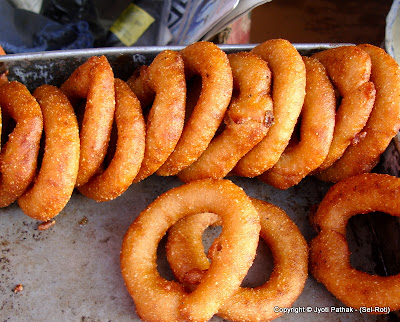Sel-Roti - Deep-Fried Rice Flour Bread - (सेल-रोटि)
Sel-Roti does not need any introduction in Nepali cuisine -- it is one of the most "uniquely Nepali" dishes, a sweet rice bread, distinct from any other breads of the world. Sel-Roti resembles a large thin puffed-up doughnut and has a crispy texture with reddish brown color. It is prepared by grinding soaked rice to create a thick batter. It is then mixed with sugar, clarified butter, mashed banana, water, poured into bubbling oil and deep-fried. It is a popular as a festive bread for many different occasions.
Traditional Nepali cooks grind the soaked rice in a heavy rectangular stone mortar and pestle (silauto-baccha), which produces a perfectly texture batter, because it provides the right pressure while grinding. These days people grind the rice in a blender for convenience. Traditional versions of Sel-Roti require the batter to be deep-fried in a pure clarified butter (gheu), but now vegetable oil has replaced gheu for a lighter version of Sel.
Sel-Roti is always prepared during the Nepali religious festivals of Dashai and Tihaar and for other special occasions such as weddings, birthdays, and family celebrations. It is also prepared as a sacred food for the gods (naivedya) and offered ritualistically to deities. Sel is distributed among friends and family as a blessed food (prashaad).

And finally, here are home-made Sel-Roti from my kitchen.....Remember the best result takes practice.... these are best enjoyed the day they are made!
Sel-Roti does not need any introduction in Nepali cuisine -- it is one of the most "uniquely Nepali" dishes, a sweet rice bread, distinct from any other breads of the world. Sel-Roti resembles a large thin puffed-up doughnut and has a crispy texture with reddish brown color. It is prepared by grinding soaked rice to create a thick batter. It is then mixed with sugar, clarified butter, mashed banana, water, poured into bubbling oil and deep-fried. It is a popular as a festive bread for many different occasions.
Traditional Nepali cooks grind the soaked rice in a heavy rectangular stone mortar and pestle (silauto-baccha), which produces a perfectly texture batter, because it provides the right pressure while grinding. These days people grind the rice in a blender for convenience. Traditional versions of Sel-Roti require the batter to be deep-fried in a pure clarified butter (gheu), but now vegetable oil has replaced gheu for a lighter version of Sel.
Sel-Roti is always prepared during the Nepali religious festivals of Dashai and Tihaar and for other special occasions such as weddings, birthdays, and family celebrations. It is also prepared as a sacred food for the gods (naivedya) and offered ritualistically to deities. Sel is distributed among friends and family as a blessed food (prashaad).
 |
| The batter puffs up and rises as it cooks. She pushes it into the oil frequently with the back of a spoon. |
 |
| ... when one side is golden brown, she flips the second side and let it cook until golden. |
 |
| ... removing the fried bread carefully with a thick wooden stick and letting the extra oil drip back in the oil before transferring into a large aluminum bowl. |
 |
| This photo is taken at the most famous local sweet shop at Maru Tole, Kathmandu, named Shree Purna Ashok Bhandar. The sweet shop staff is showing me a copper kitchen equipment specially made to pour the batter to prepare the bread. First, he places a finger at the bottom opening and fills the batter on top. When ready, he removes his finger from the plugged hole, and allow the batter to fall directly into the bubbling oil in a circular motion to create perfect Sel-Roti. |
 |
| Alternately, you can use many other equipment to pour the batter in the oil. Many cooks prefer to use half of a coconut shell with a hole on the middle to pour the batter. Some use reusable pastry bag (piping bag) made out of heavy thick cloth with the opening at the bottom end. The batter is filled in the cloth, then squeezed and pressed through the hole to shape the Sel-Roti. Some prefer leaf plates (Tapari - Bota) to squeeze the batter into the hot oil or even inexpensive squeezable large bottle with a opening is used. |
 |
| Everyone is enjoying the warm, and freshly cooked Sel-Roti... |
 |
| The above Sel-Roti is being prepared for Nepali Mother's day celebration, "Aamaa ko Mukh Herne Din - Maata Tirtha Ausi". It can be served as a snack food, breakfast food, casual and unannounced visitor of a guest, and for a social and religious gatherings. |
 |
| These are some of the video teaching demonstration (step-by-step) on how to make Sel Roti. Here is "Roshni Prashai's 16 minute video with English subtitles," click here to watch. "Mom making Sel-Roti in a wood burning stove," click here to watch the video. Another "Traditional Nepalese Sel-Roti (Crispy Rice Donuts) & Potato Pickles (16 minutes - in Nepali), please click here to watch the video. Join Sita as she cooks Sel Roti - a delicacy made with rice and sugar - for the great Nepali celebration of the Tihar festival. The Sel-Roti is unique to Nepal and has become an iconic symbol of Nepali culture and festivities. Click here to watch the video. |

And finally, here are home-made Sel-Roti from my kitchen.....Remember the best result takes practice.... these are best enjoyed the day they are made!









